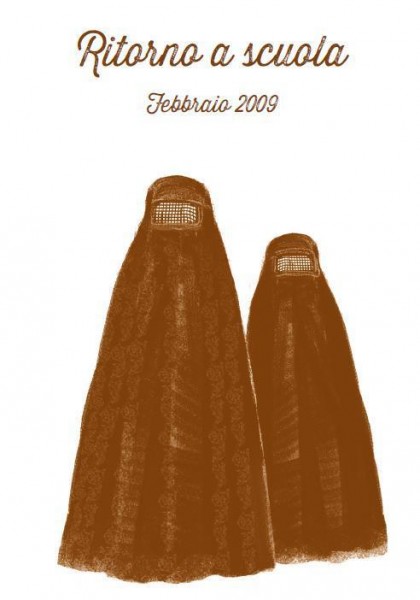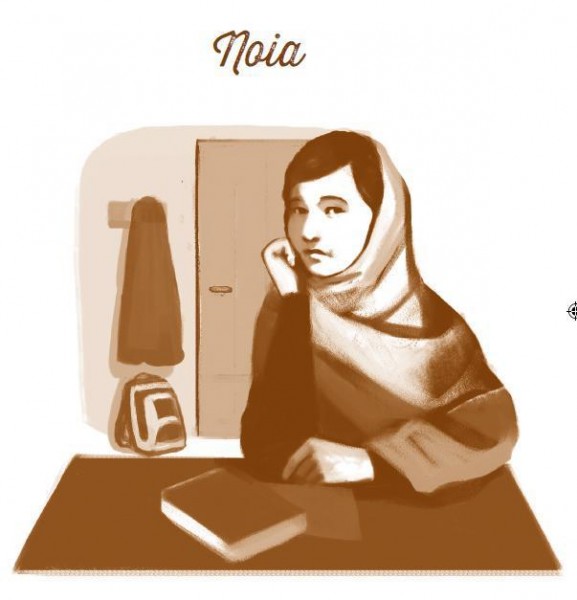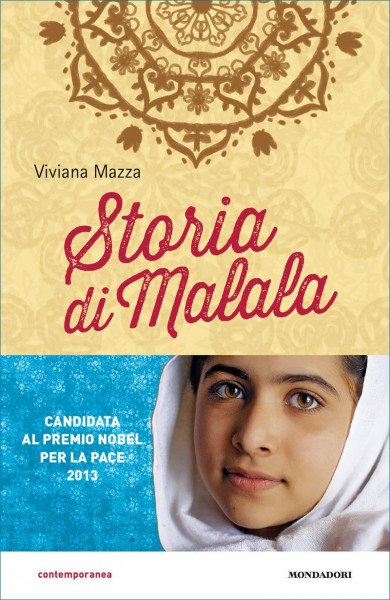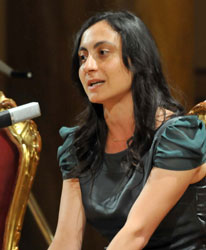Malala, the Story by Viviana Mazza
Just a few days ago,on October 13th, Diane Sawyer, one of America’s major TV anchors, had a dedicated show on Malala. Malala’s story is spreading. Here, Italian journalist Viviana Mazza was tapped by Italy’s famous Mondadori to write about Malala. -AMc
It is better, of course, to plan ahead.
“If you are planning for a year, plant rice. If you are planning for the next 10 years, plant trees. But if you are planning for 100 years, educate people.”
A 15-year-old African girl told me these words a few days ago (“it’s a Chinese proverb”, she explained) when I asked her what are the key things to do if you want to empower girls and women.
Maud Chifamba is her name. She is from Zimbabwe and, even though she is an orphan from a poor family, she passed her exams early, and she is already enrolled in university. She will graduate at 18, and she wants to be an accountant for a few years, then she wants create her own business.
Why am I telling you this story?
 Because after I was invited to write a book for kids about Malala Yousafzai, I have been catapulted into the world of “global education.”
Because after I was invited to write a book for kids about Malala Yousafzai, I have been catapulted into the world of “global education.”
It’s a world inhabited by many Malalas, girls like Maud whose names are perhaps not as well known as the name of the Pakistani girl who survived an attempt to kill her in the Swat Valley. But their determination to fulfill their dreams is as strong as hers. She fought for the right to education. The Taliban say she is a symbol of the West. She survived and has now made education a life mission.
My book is called Storia di Malala (Malala, the Story) and it’s a book for kids aged 11 and older.
 It’s written in Italian and was published on July 16th, 2013 . The woman who became my editor read one of my articles about Malala Yousafzai and called me.
It’s written in Italian and was published on July 16th, 2013 . The woman who became my editor read one of my articles about Malala Yousafzai and called me.
I wrote the book in two and a half months, working on it in every spare moment outside of my normal work.
I turned in the final draft on the day before my wedding.
Education is not the only thing I cover. In fact, I rarely covered it before I began to write my book.
I am a foreign affairs journalist who has lived, studied, and worked in the United States and the Middle East before moving back to Italy, and I still travel as frequently as I can.
Since I wrote this book, and since I started going to schools to meet teenagers who have read it, a new world has opened up for me.
I have learned that kids ask different questions from adults, and I have discovered that I really enjoy the perspective that they bring. It is changing my way of approaching stories (even the ones I write for grown-ups), it is making me ask different questions in my interviews, and I am writing differently. I have found a connection to a part of myself that I had forgotten existed.
The book’s main sources are Malala’s blog and the New York Times’ documentary made a few years before she was shot.
I also read and watched everything I could about her. There were many interviews and articles, as she was already quite well-known in Pakistan and abroad before she was shot.
I spoke with many people: some of them know her and her father (I am in contact with and I hope to be able to meet them soon); others are people who helped me to understand the smallest details about the place, including the food and the dress-code for women. I tried to depict the place where she lived and her story in a language that would be accessible to children, but without losing the complexity.
Malala’s Story is an illustrated book. There is one big illustration at the beginning of each chapter, and the chapters are quite short.
Recently, when I have gone to classes to talk about it, I bring the real pictures that served as a basis for the drawings. I like to display reality and fiction next to one another. I am still convinced that the reality is often more amazing. The kids seem to agree; they are the best readers I have ever had.
—
If you read Italian, here is a link to the first chapter of Storia di Malala.
Here is an excerpt in English, translated by Viviana for us:

Storia di Malala (Malala, the Story) by Viviana Mazza
Seven girls are standing, one next to the other, like a small battalion.
Fatima reads a letter while the camera records her: “Respectable principal, the title of my speech is: The situation in Swat. Swat Valley is paradise on earth and it’s located in the northwest of Pakistan.
Swat Valley, land of waterfalls, of lush green hills and other gifts bestowed upon us by nature. But, my dear friends, Swat has become, in the last few years, a center of Pakistani Islamic militancy. Now this idyllic and peaceful land is burning.”
At this point, Fatima raises her voice, as if by shouting she can avoid crying. “Why has the peace of the valley been destroyed? Why are they killing innocent people? Who will bring peace to our valley? Nobody. I think that nobody will. Our dreams have been shattered and let me tell you, we are doomed.
In the courtyard with light green walls and an iron railing, there is a small child from kindergarten listening to the girl’s speech. It is not clear what he’s doing there all alone, but nobody seems to notice; in this last day of school, all logic seems to disappear. Beyond the railing the mountains rise in the distance. Malala thinks about when she was young and she watched the girls who were older than her during their lessons. “Swat Valley!” she shouts, letting enthusiasm guide her. Immediately, her friends answers in a chorus: “Zindabad!”. “Swat Valley!”repeats Malala, and the others answer her again with one voice: “
It means “live forever,” and it sounds like a solemn promise they make to each other. The bell signals the end of the break. It’s not a real bell, the sound is made by a teacher with a tiny hammer beating against a metal ring hanging in the courtyard. Today It’s ringing later than usual. The principal, Ms Aghala, let the girls play longer than normal. Maybe it’s her gift for the last day of school. Before going back home, the friends hug with more warmth than usual, and despite their sadness, they laugh for a while, partly because of the excitement of the journalists’ camera fixed on them, and partly because they want to put off the feeling of loneliness that they already know will follow this moment. Malala hugs Fatima and makes her a solemn promise: “Maybe it will take time, but one day our school will reopen. When she closes the gate behind her, she declares in a loud voice: “Goodbye, class!” As soon as the camera stops recording her she turns for a moment to observe the building that, until this day, was her second home; part of her wonders if this really might be the last time.Zindabad!”
For more information about Malala, the Story in an English language post, see this post by Viviana Mazza.
—
Viviana Mazza is an award winning foreign affairs journalist with Italy’s biggest newspaper, Corriere della Sera. She was invited to write Malala’s Story by one of Italy’s largest publishing houses, and finished it just before getting married. She’s been a friend to Women Writers, Women Books, and a contributor. Follow her on Twitter.
Category: Contemporary Women Writers
Comments (3)
Trackback URL | Comments RSS Feed
Sites That Link to this Post
- Featuring Women Writers on WWWB 2013 - Women Writers, Women Books | December 31, 2013





I Love the book already! Would really love to have the English version of it if available.I’ve got an avid interest in Malala n her passion since I heard of her (which was after she was shot) Her strength of purpose n perseverance despite d obstacles inspires me.True Viviana,there re lots of malalas out here…most sadly will never get out like malala but are still heroes all d same.
I love d quote by Maud. I’m tweeting it right away! (citing her as d owner that is).
Can’t wait for this book. I have granddaughters who will love it and hopefully it will make a difference in their lives.